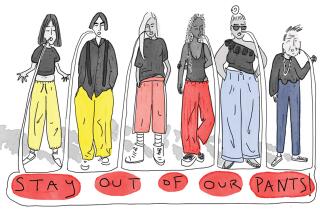Fashion 87 : Why They Will (or Won’t) Wear It
- Share via
Can a woman give a brilliant lecture if her underpants are showing?
The question plagues Jenijoy La Belle, who says she bordered on that extreme in the ‘60s, when she wore miniskirts to teach literature at Caltech.
Now the professor wonders: “Maybe instead of looking defiant, we just looked sexual.”
Whatever minis represented in the ‘60s and still represent to some women, they’re back in fashion again, and their return is creating quite a ruckus.
Will we or won’t we bare our knees? That’s the burning question. As in 1964, when Londoner Mary Quant first introduced the look, it is not college women who are terrorized by the craze, it is women over 40. Those who may have reveled in thigh-grazers during the days of Beatlemania today have a mixed reaction to their reappearance. And their reasons go way beyond questions of dress.
“I’m outraged by the whole idea,” says pioneer feminist Betty Friedan. “It’s like trying to put women into girdles again.” Friedan has no intention of wearing minis anymore, though she adds: “I still have good legs.”
Times, she says, have changed, even if fashion has not. “In the ‘60s, wearing a miniskirt seemed like a symbol of freedom,” she says. “Not now. Any woman I know over age 35 with any gumption or guts, who’s doing anything at all serious, isn’t going to wear one of those little doll outfits.”
Helen Gurley Brown , the Cosmopolitan magazine editor, who is well over 40 but who is wearing a skirt three inches above her knees even as she speaks, disagrees vehemently. “I’m crazy about minis. Betty Friedan takes it all too seriously.”
Brown doesn’t agree with Friedan that short skirts smack of sexism. “If we’ve learned anything in 15 years, it’s to wear what appeals,” she counters. “Nobody’s holding a gun to our throats.”
The Cosmo Girl says she often catches a glimpse of feminist Gloria Steinem’s knees these days, because Steinem, founder of Ms. magazine, dashes around New York in short skirts. Steinem’s are knee length, not thigh high, Brown reports. Steinem herself could not be reached for comment.
Other people prominent both in the first age of the mini and today also have opinions, ones that conflict and collide: From this side of the Atlantic, Diana Vreeland, David Hockney, Helen Gurley Brown and fashion model Peggy Moffitt; from some in London when the look first took hold, Vidal Sassoon, cover girl Jean Shrimpton and Quant herself.
Quant still puts minis in her fashion collections and still maintains: “I feel the look is right for the young and the sophisticated.”
But Shrimpton, who modeled minis to their best advantage in the ‘60s, rejects the look today. She owns the Abbey Hotel in Cornwall, England, with her husband. “A miniskirt doesn’t suit you if you’re over age 40,” she says. She’s 44.
Some women who wore minis as an act of defiance 25 years ago say they still like the look, but not on the job. “For me to walk into a courtroom in a miniskirt wouldn’t go over so well,” says Gloria Allred, the Los Angeles lawyer and feminist.
She admits to having reservations about the miniskirt revival. “I’m bothered by the pressure of conformity to wear them, when some women look great and others don’t look their best,” she says.
And she argues: “Miniskirts tend to subject women to sexual harassment and remarks.”
Nonetheless, she is wearing them after hours. “Sometimes women don’t want to be taken seriously,” she explains.
Diana Vreeland, who was editor of Vogue when minis were last in style, didn’t wear them then and will not wear them now, she says.
“You need a very long leg from the knee to the ground, which I don’t have,” she says. “Most women will wear them anyway. If they want to look absurd it’s all right. That can be rather charming.”
Artist David Hockney once inspired British designer Zandra Rhodes to translate his graphic designs to her minidress fabrics in the early ‘60s. Now he doesn’t care about miniskirts or any other fashion. He jokingly snarls, by way of his assistant Charlie Scheips: “Minis are disgusting. Skirts should be worn at the ankles.”
Southern California author Susan Littwin calls the little skirts “a rebellion against dowdiness.” She hasn’t yet decided whether she’ll wear them this time around, and explores the question in her new book, “The Postponed Generation.”
Concerning her own and other women’s resistance, she says: “We sense we’re being dictated to.” Yet, she concedes, the return of the mini seems to be a reaction “to women seeming sexually neutral.” For Littman, the condition was epitomized in man-tailored, dress-for-success women’s clothes.
Skater Peggy Fleming’s legs got plenty of exposure when she wore short circle skirts to win Olympic gold in 1968 and she still wears short skirts. But, as she notes, the meaning of the word mini has changed. It now measures from 2 to 4 inches above the knee. It used to be 6 or 8 inches above.
New York designer Bill Blass suggests that even the name has changed. “We avoid any mention of the term mini. We say short, “ he explains.
Even his older, conservative customers are wearing their skirts several inches above the knee, he says. As for age: “It has nothing to do with who wears them.”
Men, Blass says, still like short skirts best when women wear them with high heels. But women are likely to wear them with flats, at least during the day.
Blass recommends tights or panty hose the same color as the skirt--preferably black. That way, short lengths look good on women of every age.
Betsy Bloomingdale, his customer and a close friend of First Lady Nancy Reagan, says she wears her skirts above her knee.
Peggy Moffitt, who modeled Los Angeles Rudi Gernreich’s high-fashion minis more than 20 years ago, says she still wears the same designs. “I might not wear a micro-mini to my son’s PTA meeting,” says Moffitt. “But I might to an art opening.”
All of this agrees with loyalist Vidal Sassoon, who was so inspired by the skirt in the early ‘60s that he created a short, geometric haircut to go with it.
“The mini was a metamorphosis,” he says enthusiastically. “It was a true fashion breakthrough from the bouffant hair and very long skirts before it.”
Wearing one now has more to do with body awareness than social politics now, he says. “It’s a physical thing. It says: ‘Hey, I look great, I can wear a mini.’ ”
But Dr. Toni Grant argues that the return of the mini does relate to social change for women. The host of the radio’s psychology talk show asks: “I wonder if it ever occurred to feminists that many of us like minis. Many of us dress in them because they make our legs look better and make us feel more feminine and attractive to men. Today’s fashion reflects the fact that women are tired of being imitation men.”
Grant not only wears minis to the gym, she carries a pair of high heels and earrings in her gym bag.
“If I end up having coffee with someone I meet there, I slip my high heels on and feel kind of cute,” she says.
Contributing to this article were Bettijane Levine, Diane Reischel and Rose-Marie Turk.






